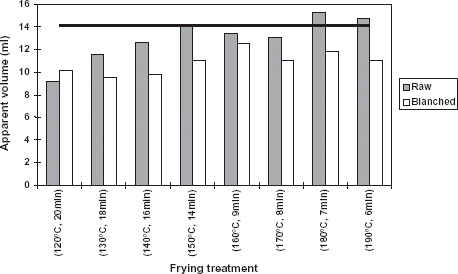Abstract
A simple method is proposed to quantify volume of potato chips by measuring the displaced volume of a finely granular material (rape seeds) by the volume of the chips. Firstly, compaction of the seeds was studied to evaluate the reproducibility and accuracy of the technique. The results obtained indicate an encouraging potential of the technique to estimate the apparent volume of potato chips and give some indications of variation of chip apparent density with some important technological parameters such as chip thickness, frying temperature, and pre-treatment of the slices before frying (e.g., blanching). This technique showed that the apparent volume of un-blanched potato slices increased clearly (P=0.007) with frying temperature (from 120°C to 190°C) until the chips reached final moisture contents <3% (wet basis). For 180 and 190°C, the final apparent volume of these samples indicated that the chips expanded in ∼6% beyond its original volume before frying (14.1 mL). For potato slices blanched in hot water (80°C and 3.5 min) and fried under the same temperature intervals and conditions, this trend was not statistically significant (P=0.088), and the average apparent volume of the chips was 10.9 mL which correspond as an average to a shrinkage of ∼23%.
Introduction
Quality of potato chips is principally defined by two factors: texture and color. Texture of fried potatoes has been extensively studied in last years.Citation1 Citation2 Potato chip texture is often described in terms of crispness, hardness, crunchiness, etc.Citation3 Citation4 Citation5 Texture analysis of chips usually did not produce reproducible results due to the irregular shape, size, curvature of the samples, and complex topographies of the fried samples.Citation6 One of the reasons for irregular shape and curvature in potato chips is that the structure of potato chips resembles a solidified open foam with bubbles or blisters on the surface. The formation of these bubbles is due to the water vaporization from the potato tissue during the frying. Difficulties are found in quantifying the porous structure of potato chips. An x-ray microtomograph of a small piece of potato chip could give the possibility of quantifying these air spaces.Citation7 Besides, some modern techniques such as the scale-sensitive fractal analysis could be useful to describe quantitatively complex aspects of the surface topography of some foods (potato chips included) such as roughness.Citation8 Citation9 However these techniques are rather expensive, which limits the possibility to use them in control quality analysis during the potato chip production.
Cheap, fast, and simple methods to measure the apparent volume in some porous solid foods, such as bread and cookies have been applied for many years. These methods are based on measuring the displaced volume of a finely non-deformable granular homogenous material by the sample.Citation10 Citation11 Citation12 Citation13 Citation14 They could be applied to determine the apparent volume of other food porous food materials such as fried potatoes, as well. Reducing the size of the granular material could increase the accuracy of the measurement. However, from a technological point of view, the employment of commonly used granular materials for measuring volume in bakery products such as rape seeds (diameter of ∼2 mm) could be enough as a first attempt to give a measurement of the complex structure developed by potato during frying. One advantage of the proposed method is that it can be applied to a small sample of fried chips (10 chips) and still achieve technologically relevant resolution of the apparent density. In comparison to the standard bread method it also requires less rape seeds making it cheaper and faster.
In this paper, a simple method was described to measure the apparent volume of potato chips based on the displacement volume of rape seeds by the fried slices. At the same time, some indications are given of how the apparent volume or density may be affected by technological parameters such as chip thickness, blanching, and frying temperature. This technique was designed for texture research but could be applicable easily and fast for routine quality control as well.
Materials and Methods
The principle of the method is to measure the volume of a finely granular material that is displaced by the volume of the potato chips with known weight. The granular material used was rape seeds (Brassica napus), which are spherical and free flowing with a typical diameter ∼2 mm.
Procedure of the Volume Measurement Method
| 1. | A 400 mL-glass beaker (diameter of 7 cm and height of 13 cm called beaker 1) was filled so that the seeds formed a conical heap above the top of the beaker. Then the seeds were pressed down manually (F∼10 N) with a metal slab and the excess of seeds was removed by sweeping with the metal slab level with the beaker brim [Fig. (A)]. | ||||
| 2. | The seeds were transferred carefully to a larger beaker. | ||||
| 3. | The beaker 1 was filled by alternate layers of seeds from the larger beaker and samples (potato chips previously weighed, ∼10 g) as in Fig. (B), and then the step 1 was repeated. | ||||
| 4. | The excess of seeds from step 3 was measured in a graduated glass cylinder (25±0.2 mL) and this volume was taken as a measure of the apparent volume of the samples. From this volume, apparent density of the potato chips was calculated by dividing the measured apparent volume by the sample weight. | ||||
Figure 1. Graphical representation of the procedure to measure the apparent volume of potato chips. (A) Step to calibrate the amount of rape seeds to use. (B) Step to quantify the volume occupied by the potato chips.

Preliminary experiments without compaction and with different compaction methods (tapping, vibration, compression) were carried out. Best reproducibility was found with compression. To determine the effect of compression on rape seed packing density, a mechanical analogue of the manual compression was used. Compaction tests were performed in beaker 1 with a flat probe (130×130×3 mm) at constant crosshead speed of 200 mm min and variable maximum forces (0–30 N) using a Universal Instron Machine (model 4442, Buckinghamshire, UK). The weight of compacted seeds was measured after removal of the seed excess from the beaker as above for each applied force.
Applications of the Method
Commercial potato chips from OLW, AB (Sweden) were characterized by the proposed technique. Three different types of potato chips were used: Lövtunna chips (with several blisters and rather flat surface, nominal slicing thickness 1.65 mm), Naturchips (with also several listers but quite irregular and bent surface, 2.03 mm), and Räfflade chips (with a wavy cut and no obvious presence of air-bubbles, 1.78).
The effect of technological variables was assessed with laboratory fried slices from Bintje tubers. For the effect of chip thickness, potato slices were cut at different thickness (1, 2, 3, and 4 mm) with an electric slicing machine (Berkel, model 800) and 70 slices were fried at 180°C in a home fryer (Fritel Super 25, Kemakeur, Belgium) at varying times (for each thickness) until they reached a final moisture content <3% (wet basis). Additionally, 2 mm slices were trimmed to diameter of 30 mm and fried in batches of ∼140 g in the home fryer at varying initial oil temperatures (160, 170, 180, and 190°C) until they reached a final moisture content <3% (wet basis).
To check the effect of frying at a constant temperature, small batches, ca ∼20 g, (n=10) of slices (diameter of 30 mm and thickness of 2 mm), raw or blanched were fried at constant frying temperature (±1°C) from 120°C to 190°C at 10°C intervals until reaching moisture contents ≤3% (wet basis). For blanching the potato slices were treated 10 min before frying in 5 L of water at 80°C for 3.5 min and excess water was partially removed with paper tissue. Statistical analysis was done using Minitab Release 12.2 for Windows (Minitab Inc., USA).
Results and Discussion
The effect of the compressing force in compacting the seed is shown in Fig. . The seed weight increased markedly until 5 N, and a relatively constant weight was obtained above that force. When the experiment was performed manually the seed weight obtained was 279.2 g with a standard error of 0.22, which corresponds to approximately 10 N. The compacting step was reproducible, either manually or instrumentally, yielding 0.18 and 0.11% of data variation, respectively. These results indicate that manual compression of the seed did not produce significant variation in the volume measurements.
Figure 2. Standarizing of the seed compacting. Points correspond to mean and standard error for five replicates.
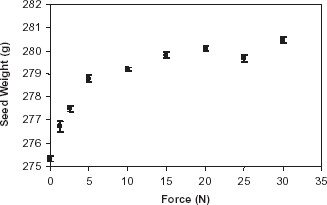
Results from the commercial chips are shown in Fig. . Potato chips with irregular shapes (Naturchips) were significantly different (P<0.001) and have higher apparent density values (0.45 g mL vs. 0.38 g mL and 0.39 g mL, respectively) than those potato chips with more uniform surface (Lövtunna and Räfflade). The standard error, in all cases, was small, which indicates good reproducibility of the technique. Thus chip densities could be a relevant control parameter easy to measure with this technique.
Figure 3. Specific density of commercial potato chips. Columns and bars are the means and standard errors of eight replicates. Columns with the same patterns are not significantly different (P>0.05).
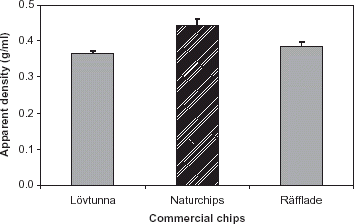
The results from laboratory fried chips of different thickness are shown in Fig. , and indicate that the apparent density values of fried chips were not significantly different (P=0.39), and a linear trend to lower density with larger thickness was not statistically significant (P=0.20). The thinner chips appeared to give results with larger variation, but the differences were not significant (all Bonferroni confidence intervals for standard deviations overlapped).
Figure 4. Specific density of chips with different initial nominal thickness. Columns and bars correspond to the means and standard errors for six replicates.
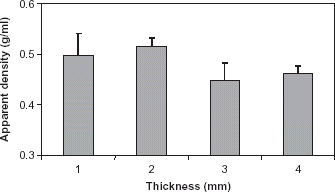
Chips fried at varying initial oil temperature yielded the results shown in Fig. . The chips fried at 160°C chips were denser (P<0.0001) than those fried above 160°C in ∼20%. No significant differences were found for chips fried at higher temperatures (≥170°C) which showed apparent density values of ∼0.5 g mL.
Figure 5. Specific density of chips fried at different initial oil temperatures. Columns and bars correspond to the means and standard errors for six replicates. Columns with the same pattern are not significantly different (P>0.05).
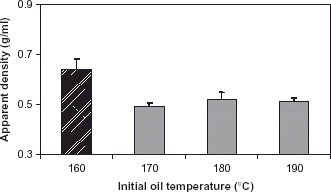
Figure shows the volume of 10 slices after being fried at different constant temperatures from 120°C to 190°C for different times until reaching final moisture contents <3% (wet basis). Final apparent volume in raw-fried samples tended to increase clearly with the frying temperature (P=0.007) and the chips expanded in ∼6% (average value) beyond the original volume of the ten slices (14.1 mL) at the frying temperatures of 180 and 190°C. In blanched samples, this trend was not statistically significant (P=0.088). Fried un-blanched samples were significantly more voluminous, corresponding to being thicker by 0.3 mm than the corresponding blanched samples (paired t-test, P=0.007). Apparent density measurement can be made without knowing the original volume of the sample, but its interpretation is made less straightforward by the weight of the absorbed oil. The changes of volume during frying may be more clearly related to technological parameters.
Conclusion
The results obtained from this study suggest an encouraging potential of the proposed technique to estimate and differentiate the volume of potato chips, to follow chip quality and to study the relationship between textural phenomena in chips and some processing technology parameters such as oil temperature, pre-treatment, etc.
Acknowledgments
The authors wish to acknowledge the financial support from The Nordic Industrial Fund (NIF), and Chips AB (Sweden) for supplying the samples. We would also like to thank to the Vicerrectoría de Investigación y Desarrollo (DICYT) of the Universidad de Santiago de Chile and FONDECYT Project No. 1030411.
References
- Pedreschi , F. , Aguilera , J. M and Pyle , L. 2001 . Textural characterization and kinetics of potato strips during frying . J. Food Sci. , 66 : 314 – 318 .
- Segnini , S. , Dejmek , P. and Öste , R. 1999 . Relationship between instrumental and sensory analysis of texture and color of potato chips . J. Tex. Studies. , 30 : 677 – 690 .
- Bourne , M.C. , Moyer , J.C and Hand , D.B. 1966 . Measurement of food texture by a universal testing machine . Food Technol. , 20 : 170 – 174 .
- Smith , O. 1975 . “ Potato chips ” . In In Potato Processing, , 3rd Ed. Edited by: Talburt , W.F. and Smith , O. 305 – 402 . Westport, Connecticut : The Avi Publishing Company, Inc. .
- Segnini , S. , Dejmek , P. and Öste , R. 1999 . Reproducible texture analysis of potato chips . J. Food Sci. , 64 : 309 – 312 .
- Katz , E.E. and Labuza , T.P. 1981 . Effect of water activity on the sensory crispness and mechanical deformation of snack food products . J. Food Sci. , 46 : 403 – 409 .
- Segnini , S. 2000 . Texture and Color of Potato Products Lund, , Sweden : Lund University . Ph.D. Dissertation
- Pedreschi , F. , Aguilera , J.M. and Brown , C.A. 2002 . Characterization of the surface properties of chocolate using scale-sensitive fractal analysis . Int. J. Food Properties , 5 ( 3 ) : 523 – 535 . [CROSSREF]
- Pedreschi , F. , Aguilera , J.M. and Brown , C.A. 2000 . Characterization of food surfaces using scale-sensitive fractal analysis . J. Food Process Eng. , 23 ( 2 ) : 127 – 143 .
- Csanad , I. and Kun , I. 1970 . Study of the volume of bakery foods. Determination of the lower limiting value of volume . Elelmiszervizsgalati Koezlemenyek , 16 ( 2 ) : 99 – 104 .
- Grass , P.W. and MacRitchie , F. 1973 . An improved method of volume measurement for small loaves . Cereal Sci. Today , 18 ( 5 ) : 135 – 137 .
- Krishnaprasad , A. and Sidhu , J.S. 1987 . Effect of cereal and tuber starches on the cookie quality . Chemie Mikro Techn. Lebens. , 11 ( 3 ) : 89 – 94 .
- Rassis , D. , Nussinovitch , A. and Saguy , I.S. 1997 . Tailor-made porous solid foods . Int. J. Food Sci. Techn. , 32 ( 4 ) : 271 – 278 . [CSA] [CROSSREF]
- Bail , A. , Grinand , C. , Cleach , S. , Martinez , S. and Quilin , E. 1999 . Influence of storage conditions on frozen French bread dough . J. Food Eng. , 39 ( 3 ) : 289 – 291 . [CROSSREF]
